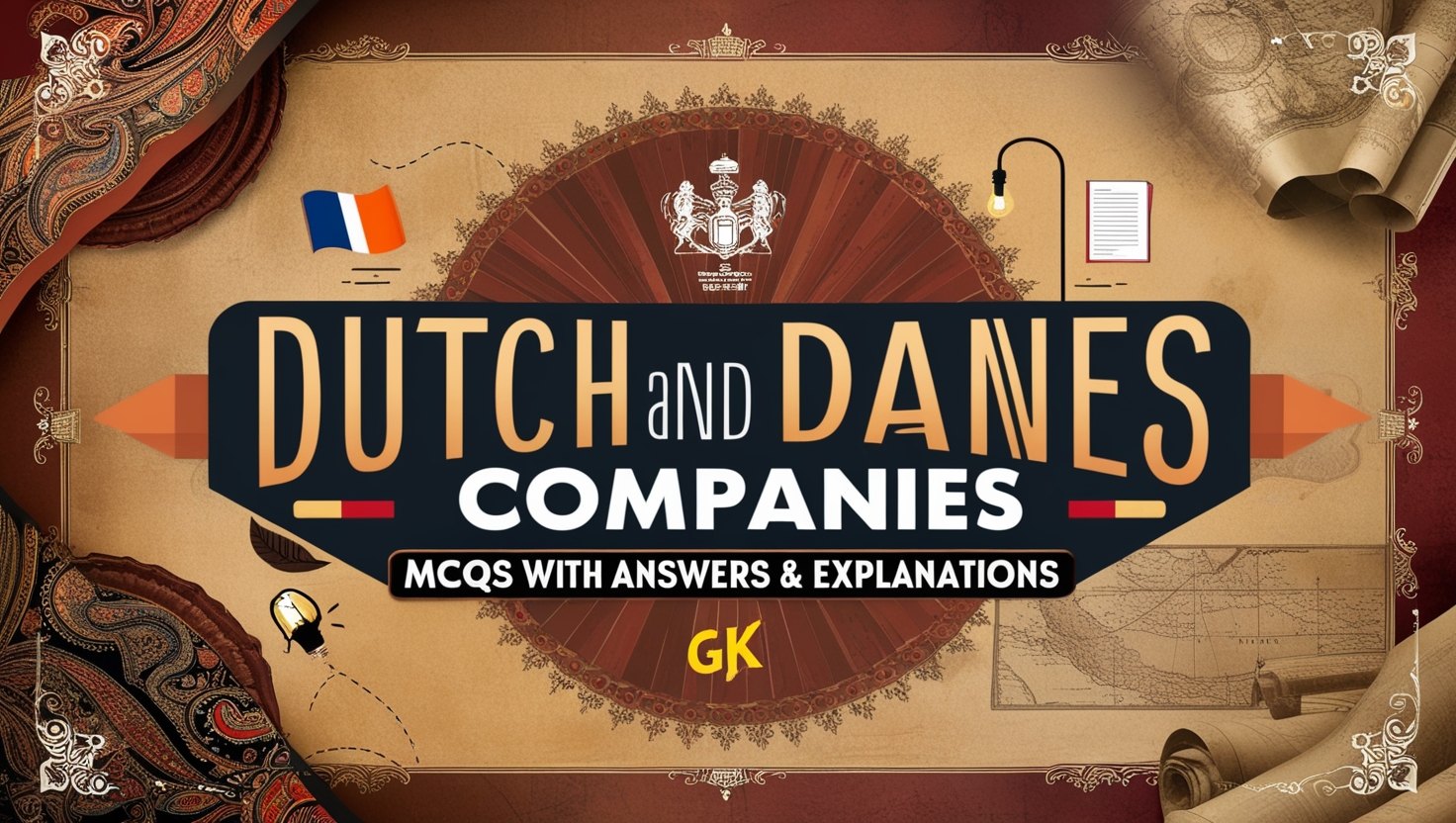
If you’re preparing for competitive exams or simply looking to expand your knowledge about the business world, understanding companies from different countries is crucial. This collection of Dutch and Danes Companies GK MCQs with answers and explanations will help you gain valuable insights into major companies from the Netherlands and Denmark. Each question is designed to test your knowledge and provide a detailed explanation to help you understand the intricacies of these businesses. Whether you’re a student, professional, or general knowledge enthusiast, this guide will enhance your understanding of Dutch and Danish companies.
- Which among the following was the first establishment of the Dutch in the current territories of Odisha?
- Calcutta
- Chinsura
- Pippli
- Balasore
Show Answer
Answer: Pippli
Pippli, located in the present-day state of Odisha, was the initial place where the Dutch established a trading post in the region. However, this early settlement in Pippli was eventually abandoned by the Dutch in favor of Balasore, which likely offered better trade opportunities and strategic advantages.
2. Who were the first to start a joint stock company to trade with India?
- Portuguese
- Dutch
- French
- Danish
Show Answer
Answer: Dutch
The Dutch East India Company (VOC) is credited with establishing the world’s first official stock market in Amsterdam on March 20, 1602. This market allowed investors to speculate on commodity futures and buy shares in the company, making it an early example of a joint-stock company. The VOC played a pioneering role in the development of modern stock exchanges, which contributed to their success as a trading enterprise, including their activities in India.
3. The first factory by the Dutch was established at which among the following places?
- Surat
- Machilipatnam
- Negapatnam
- Pulicat
Show Answer
Answer: Machilipatnam
The Dutch East India Company established its first permanent trading post in India in the coastal town of Machilipatnam, also known as Masulipatnam, in 1605. Subsequently, the Dutch expanded their presence in the region by establishing factories, or trading posts, at other key locations, including Pulicat, Surat, and various other places. These factories facilitated Dutch trade in India and were part of their broader efforts to engage in commerce and maximize profits.
4. For which of the following commodities did the Dutch want to barter cotton piece goods in the Indonesian Archipelago?
- Tobacco
- Rice
- Pepper and Spices
- Silk
Show Answer
Answer: Pepper and Spices
The Dutch East India Company engaged in trade with India and carried a variety of commodities from the subcontinent. Some of these commodities included silk, cotton, indigo, rice, and opium. Additionally, in the Indonesian Archipelago, they aimed to barter their cotton piece goods for valuable spices like pepper and other spices, which were highly sought-after in Europe and formed a significant part of their trade with the East Indies.
5. In which year did the first fleet of the Dutch reach India?
- 1498
- 1510
- 1550
- 1595
Show Answer
Answer: 1595
In 1595, the first fleet of Dutch ships, led by Cornelis de Houtman, reached the shores of India. This early Dutch expedition marked the beginning of their interactions with the Indian subcontinent. Following this arrival, the first Dutch trading factory was established in Masulipatnam (modern-day Andhra Pradesh), signifying the Dutch East India Company’s initial steps in India.
6. Pipali in Bengal is best known for which of the following?
- First Dutch Factory
- First Portuguese Factory
- First French Factory
- First British Factory
Show Answer
Answer: First Dutch Factory
Pipali in Bengal was known for being the first place where the Dutch had established their factory in the current territories of Odisha. However, it was soon abandoned for Balasore.
7. The Jakarta History Museum located in old Jakarta, Indonesia, was once used as the headquarters of which of the following?
- British East India Company
- Dutch East India Company
- Portuguese East India Company
- Danish East India Company
Show Answer
Answer: Dutch East India Company
The Jakarta History Museum, commonly known as Fatahillah Museum, served as the headquarters of the Dutch East India Company (VOC) in the historic area of Old Jakarta, Indonesia. The museum is a significant historical site that reflects the Dutch colonial presence in the region and showcases artifacts and exhibits related to that period.
8. Which among the following was the first European nation to break through the Portuguese monopoly in the east?
- France
- Netherlands
- Britain
- Sweden
Show Answer
Answer: Netherlands
The Dutch East India Company was involved in armed conflicts with the Portuguese Empire as they sought to break the Portuguese monopoly on trade routes and colonies in the East Indies, including India. Their efforts to challenge Portuguese dominance in the East extended to various regions, including the Americas, Africa, India, and the Far East, as part of their broader competition for control of lucrative trade routes.
9. Who was the first Dutchman to reach India?
- Houtman
- Philip I
- Philip II
- None of the above
Show Answer
Answer: Houtman
Cornelis de Houtman is recognized as the first Dutchman to reach India, specifically the regions of Sumatra and Bantam, in 1596. He undertook this significant voyage, and upon his return in 1597, he brought back a valuable cargo, contributing to the Dutch East India Company’s early involvement in trade with the East Indies.
10. What was the main objective of the Dutch company to come to India?
- Expansion of Empire
- Trading
- Plundering of wealth
- Proselytizing
Show Answer
Answer: Trading
The primary objective of the Dutch East India Company in India, as in other regions, was trade. Their primary focus was to establish and operate trading centers or factories in strategic locations, engage in commerce with local markets, and maximize profits from the exchange of goods and commodities. The Dutch East India Company was a pioneering example of a commercial trading enterprise in the early modern period.


Leave a Reply